Turning an Old Abstract Painting into an Urban Sketch: A Creative Journey
INSTAGRAM EXTRASCREATIVE PROCESS
I spy with my mind's eye...
.....something that looks like...well see for yourself.
Recently I was going through the ever growing stack of pages (lying on top of my conveniently placed PC next to my desk), to basically tidy up and make room for the next pile of ideas, doodles, and unsuccessful sketches that end up as scrap bits of test paper.
During this 'clean out' I came across a selection of A5 sheets of paper, where I had started to create some abstract paintings, probably during a time where I didn't know what to sketch or where I just fancied a change. After letting them dry and saying to myself 'I'll do them later', they eventually ended up in the tower of scraps.
As I looked at them, deciding if they were for the bin, or if I would have the patience to carry on with them, I noticed in a couple of them, that there were some random shapes that looked like buildings. The more I looked, the more I saw a sketch appearing in my mind's eye.
I started doodling on one of the abstract paintings (seen here) using the original ink lines and painted shapes, but also adding some of my own extra lines to create the following sketch.
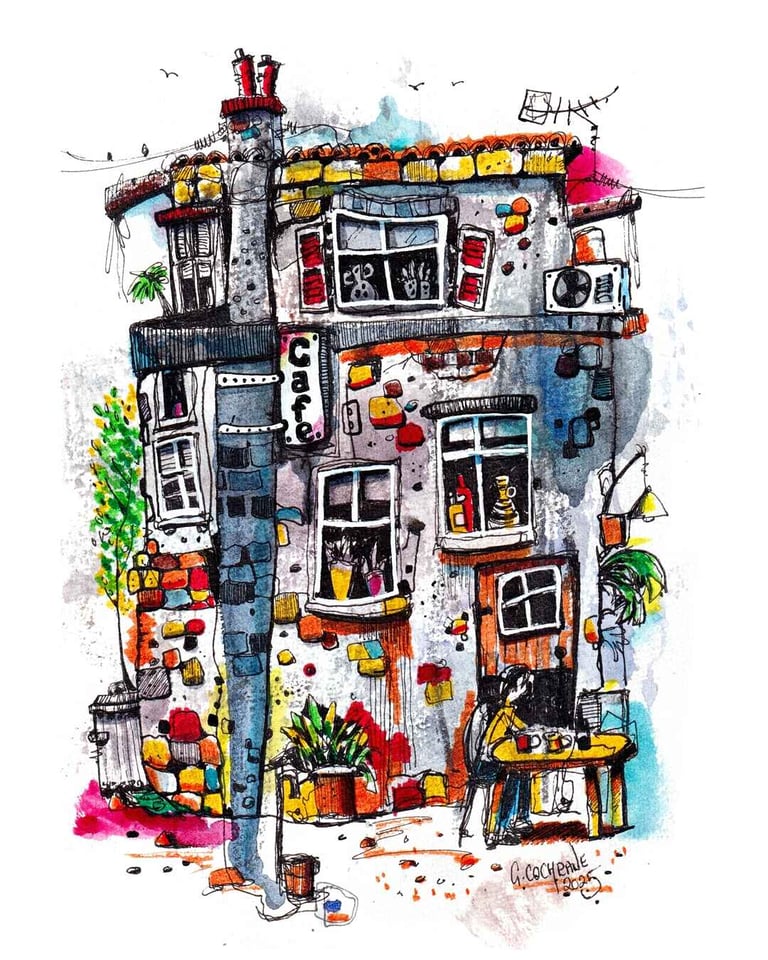

Unfortunately I didn't scan the initial abstract abstract painting before I turned it into a back street cafe.
It was only after the amount of fun comments that I received from many of my followers on this image, that I decided to document my whole process on how I go about transforming an abstract painting that was destine for the paper bin, into a fun, loose and colourful sketch, worthy of posting in my Instagram gallery.
The fear of the dreaded 'blank page'.
I'm sure each and every one of us have encountered the daunting experience of facing a blank canvas. This universal fear can often lead to hesitation, self-doubt, and even a reluctance to begin. However, transforming an old abstract painting into an urban sketch presents a compelling opportunity to channel these creative anxieties into productive exploration.
By repurposing existing artwork, you can effectively bypass the intimidation of starting fresh, allowing you to engage with your creativity in a more dynamic manner.
The idea of turning a previous piece of artwork, into a sketch allows for the incorporation of various artistic styles while preserving the essence of the original work.
In this process, the abstract painting not only serves as a foundation—an inspirational spring board with techniques, shapes and colours, ready to liberate you from the constraints of blankness, but also encourages the exploration of different themes and perspectives that stem from the original artwork.
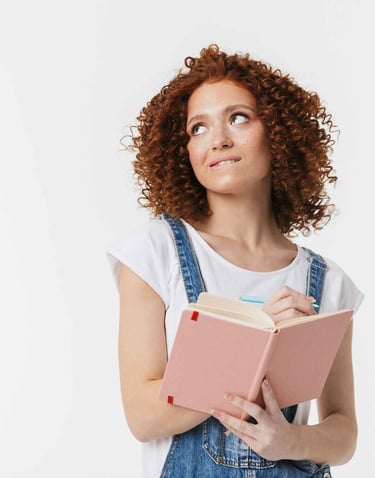

Finding Shapes in Abstraction: The First Steps
The journey of transforming an old abstract painting into an urban sketch begins with a careful analysis of the abstract shapes present within the artwork. At first glance, abstract art can appear chaotic or formless; however, a deeper examination often reveals a wealth of structural elements waiting to be discerned. The key here is to approach the piece with an open mind, allowing one’s creativity to take flight as you begin to identify forms that resonate with you.
For this post I will be using the following A5 sized abstract art painting.
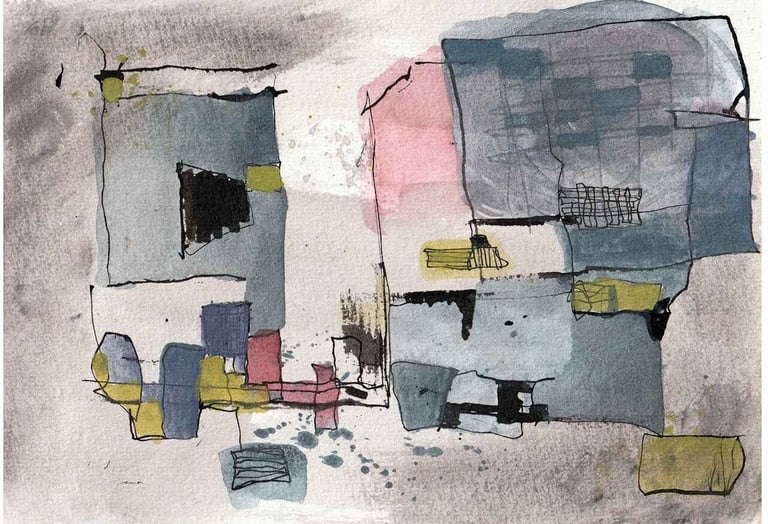

To effectively extract recognizable features from the abstract, start by breaking down the painting into basic shapes. This can be achieved by observing the contours and lines, focusing on the interplay of light and shadow. Look for triangles, circles, rectangles, and other geometrical forms that provide a foundation upon which recognizable subjects can be established.
It may also help to utilize a grid system or some form of overlay to assist in pinpointing specific areas of interest. This technique compels you to view the painting in a more structured format, allowing for the extraction of individual elements that can be refined further. Consider which shapes can be repurposed or combined to symbolize urban features such as buildings, trees, or street scape details.
As mentioned earlier, after posting my first repurposed abstract sketch I have had a lots of requests as to what is going on in my head and how I come up with the ideas and end results.
A picture paints a thousand words so in the next image I have marked out (by using a free, but simple and effective photo editing software called Photoscape) the shapes that got imaginative juices flowing.
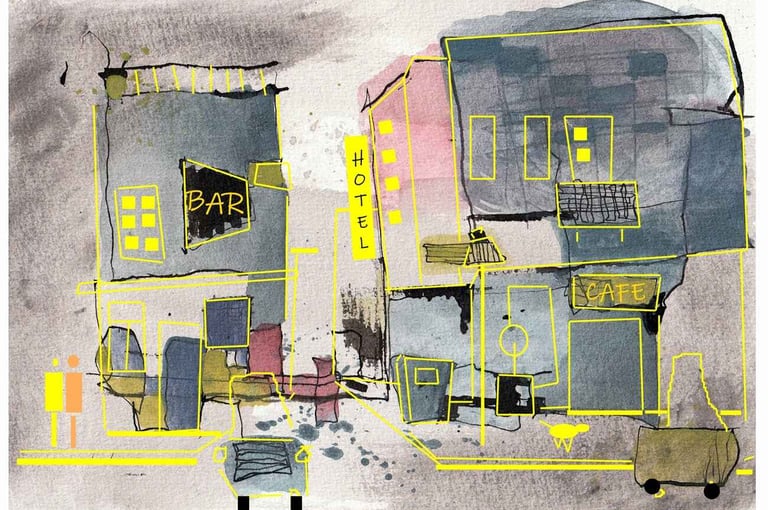

Once I have marked out the major shapes and rough composition of my sketch, I then move onto the next stage.


Transforming Shapes into Sketches: Techniques and Tips
Transforming abstract shapes into cohesive urban sketches requires a blend of observation and creativity. One effective technique is to start by analyzing the shapes in the original painting. Identify the key elements that stand out and contemplate how these forms can translate into architectural features, figures, or natural landscapes. Focus on the contours and movement inherent in the abstract work, as these characteristics can serve as the foundation for urban scenes.
When sketching from an abstract painting, begin with loose lines to capture the essence of the shapes. Use a light touch with your pencil or brush to ensure that you maintain flexibility in your sketches. This phase is essential as it allows you to explore different compositions without being confined by the original artwork's rigidity. Acknowledge that imperfections can lead to unique, interesting results that contribute to the vitality of your urban sketch.
Incorporating elements such as architectural details will enhance your urban sketch. Select a few significant shapes from the abstract piece and manipulate them into recognizable structures or streetscapes. Consider utilizing various perspectives to create depth; this can be achieved by juxtaposing elements that recede into the background with those that are more prominently placed. Furthermore, adding human figures can enrich the scene, providing context and life to your urban sketch.
Additionally, maintaining a sense of looseness and spontaneity in your sketches is crucial. Embrace the fluidity of your artistic process—allow the pencil to flow and enjoy the exploration of your ideas. Give yourself the freedom to experiment with different styles and techniques, blending realism with abstraction when necessary. This approach not only personalizes your sketches but also encourages creativity, leading to a more vibrant representation of the urban landscape inspired by your original abstract painting.

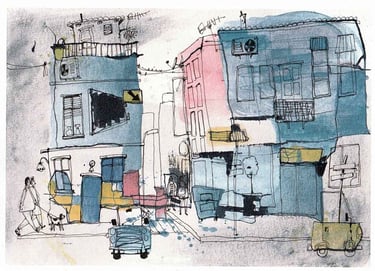
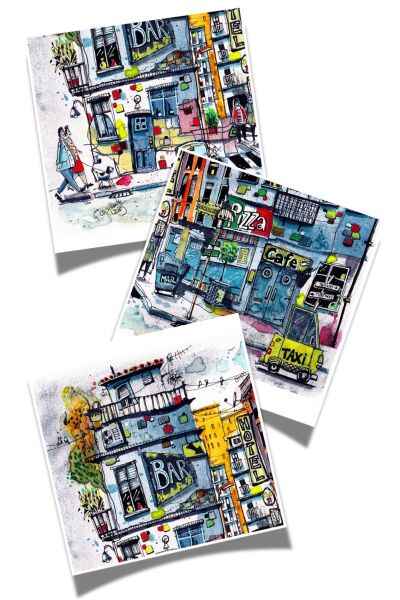

Don't just go with the first choice...take the painting for a spin!
If you stare at a piece and you can't see any significant shapes that are inspiring you to put pen to paper, then give it a spin and look at it from other angles. Below you can see the other options that I have created using the same old abstract, just by turning the page through 360°.
These other versions will surely be making an appearance in my Instagram gallery in the future when I'm staring at a blank page.
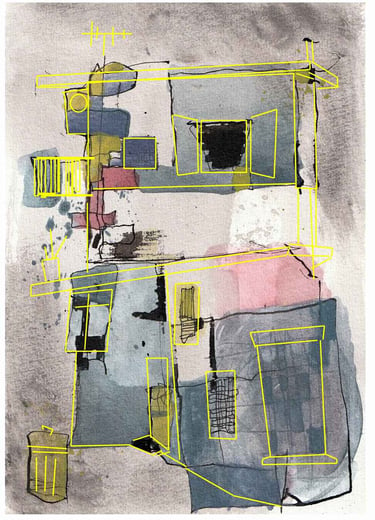

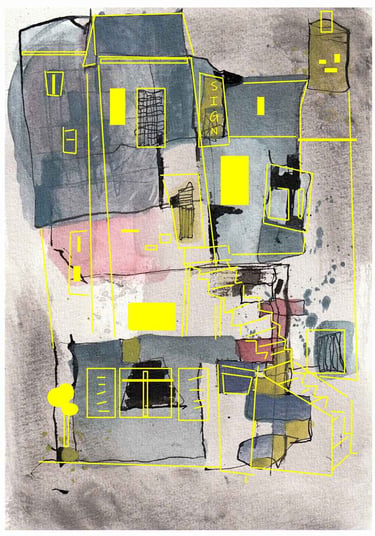

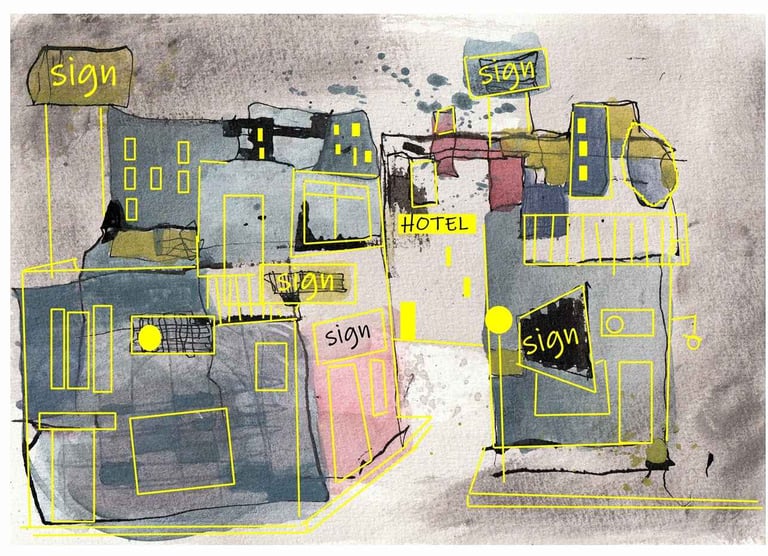

Letting Go of Perfection: Embracing Spontaneity in Art
In the world of art, there exists a notion that perfection is the ultimate goal. However, increasingly, artists are discovering the value of embracing spontaneity, particularly in the context of turning an old abstract painting into an urban sketch.
Embracing imperfection encourages you to break away from rigid techniques and preconceived notions of what an artwork should embody. This shift in perspective transforms the artistic process into an exploratory adventure, where unplanned strokes or unintended color combinations add character and depth to the piece. In an urban sketch, the dynamic and ever-changing nature of the surroundings may inspire a more relaxed approach, allowing you to capture fleeting moments spontaneously.
The importance of spontaneity lies in its ability to cultivate a more personal and emotional connection between you and your creation. An unfinished line or a bold splash of color can serve as a testament to the creative journey.
As you begin to liberate yourself from the burden of perfection, you will often find that your work resonates more authentically with both yourself and your audience. In this sense, acknowledging that not every stroke must be flawless can open new pathways to creativity, fostering a spirit of experimentation that is crucial to your artistic expression.
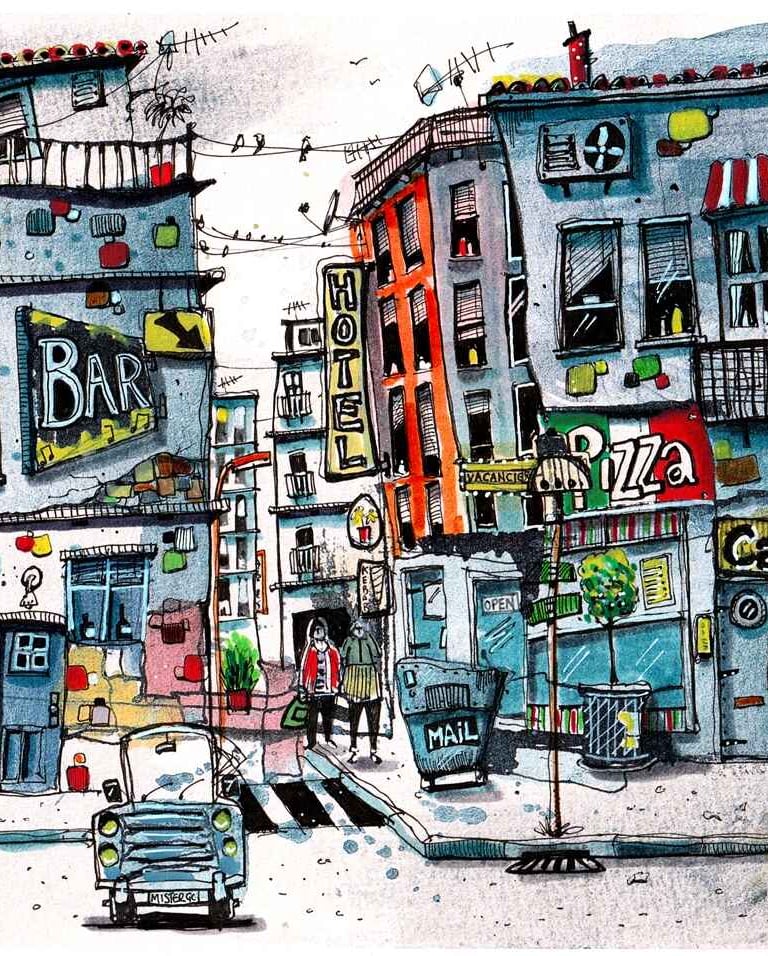

Even though this car seems to be parked in the middle of the junction, it is one of my favourite elements in this sketch. The less said about the mail box, the better...but I still love it!
They may not be perfect but I think they are pretty.
Reflecting on the Process: Insights and Lessons Learned
The transformation of this old and unfinished abstract painting into an urban sketch serves as a testament to the continuous nature of artistic exploration. This project was not merely about the physical act of reinterpreting a painting; it was a valuable lesson in evolving my perception of creativity. As I navigated through this process, several insightful lessons emerged that may resonate with you or other artists and creative individuals.
Firstly, embracing change is pivotal in any artistic endeavor. Initially, the abstract painting seemed ready for the bin or at least another addition to my bundle of test/scrap papers. However, revisiting it allowed for an exploration of new dimensions and creativity.
Secondly, due to the fact that I printed the original A5 size abstract onto an A4 size sheet of watercolour paper, the lines and shapes were not printed with waterproof ink, which in turn forced me to use other mediums such as my acrylic pens, which have been lying around unused for ages and a selection of felt tips pens too.
I must say I'm looking forward to using these pens and markers more often, alongside my beloved watercolour paints.
This underlines the importance of being open to new creative ideas, techniques and processes, which can serve various purposes and take on different forms over time. Engaging with the piece afresh helped me to appreciate the versatility inherent in art, illustrating that something perceived as 'rubbish' can always be revised and given new life.
In concluding this post, I encourage you to challenge your own artistic boundaries. Experimenting with existing works, whether they are abstracts or other mediums, can unveil hidden potentials and inspire new creative pathways. Embrace the uncertainties that come with artistic experimentation, for they may pave the way for unexpected and rewarding outcomes.
Every piece of art holds the promise of transformation; it’s your role as an artist to nurture and explore this potential.



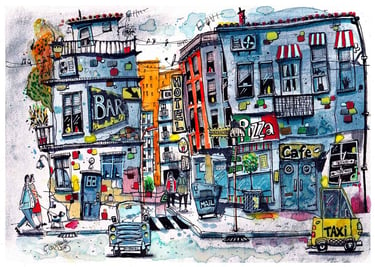
From this...
...to this
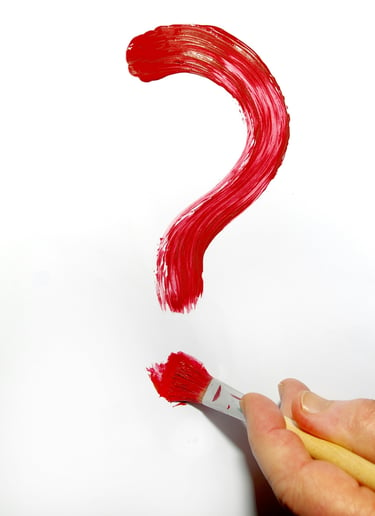

Got any questions?...
then please feel free to use the Contact Form or reach out to me on this post on Instagram. All questions, suggestions and comments will be answered as soon as possible. Thanks for reading and happy creating!
